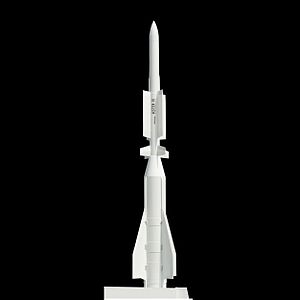Aster (missile family)
| Aster | |
|---|---|

MBDA Aster 30 on display showing attached booster.
|
|
| Type |
Aster 15: Short/medium range anti-aircraft and anti-missile missile. Aster 30: Long range anti-aircraft and anti-missile missile. |
| Place of origin | France / Italy |
| Service history | |
| In service | 2001 |
| Production history | |
| Manufacturer | MBDA / Thales Group / Eurosam |
| Specifications | |
| Weight |
Aster 15: 310 kg Aster 30: 450 kg |
| Length |
Aster 15: 4.2 m Aster 30: 4.9 m |
| Diameter | Aster 15: 180 mm |
| Warhead | Directed fragmentation. |
|
Detonation
mechanism |
Direct contact or proximity. |
|
|
|
| Engine | Solid propellant two-stage rocket. |
|
Operational
range |
Aster 15: 1.7–30+ km Aster 30: 3–120 km |
| Flight altitude |
Aster 15: 0–13 km Aster 30: 0–20 km |
| Speed |
Aster 15: Mach 3.5 (1,191 m/s) Aster 30: Mach 4.5 (1,531 m/s) |
|
Guidance
system |
|
|
Launch
platform |
|
The Aster missile series, primarily comprising the Aster 15 and Aster 30 are a family of vertically launched surface-to-air missiles. The name "Aster" originates from the mythical Greek archer named Asterion (in Greek mythology), Asterion likewise receiving his name from the ancient Greek word aster (Greek: ἀστήρ), meaning "star". Aster is manufactured by Eurosam, a European consortium consisting of MBDA France, MBDA Italy (combined 66%) and the Thales Group (33%). The missile is designed to intercept and destroy a wide range of air threats, such as supersonic anti-ship cruise missiles at very low altitude (Sea-skimming) and fast flying, high performance aircraft or missiles.
Aster is primarily operated by France, Italy, and the United Kingdom and is an integrated component of the PAAMS air-defence missile system, known in the Royal Navy as Sea Viper. As the principal weapon of the PAAMS system, Aster equips the Type 45 destroyers and the Horizon class frigates. Aster also equips the French and Italian FREMM multipurpose frigates, though they will not be operating as part of a PAAMS air-defence suite.
During the 1980s, the predominant missiles in Franco-Italian service were short-range systems such as the French Crotale, Italian Aspide or American Sea Sparrow, with ranges up to a dozen kilometres. Some vessels were also equipped with the American medium/long range Standard. France and Italy decided to start development of a domestic medium/long range surface-to-air missile to enter service in the first decade of this millennium, that would give them comparable range but superior interception capability to the American Standard or British Sea Dart already in service. Thought was given in particular to the new missile's ability to intercept next-generation supersonic anti-ship missiles, such as the Brahmos missile developed jointly by India and Russia. This allowed the actual systems to have the characteristic of being specialised either in short-to-medium range "point defence" (ships, for instance), or in medium-to-long range "zone defence" (fleets).
...
Wikipedia
